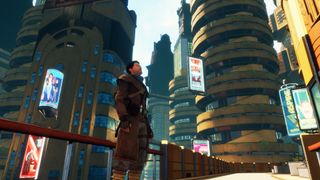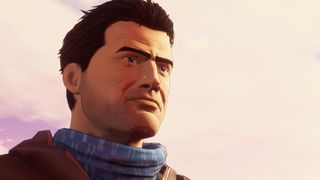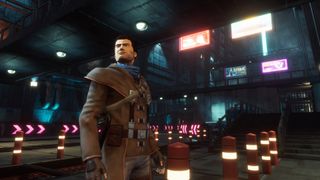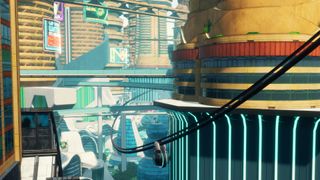2 hours with Beyond a Steel Sky, a cyberpunk adventure from the creator of Broken Sword
Return to Union City.

Back in 1994, Broken Sword creator Revolution Software released Beneath a Steel Sky, a cyberpunk point-and-click adventure set in a dystopian metropolis called Union City. Now, 26 years later, the studio is developing a sequel. Union City is the setting once again, only this time our hero, Robert Foster, isn't trying to escape—he's trying to get in.
You're introduced to Union City in the first act, and it's an impressive sight. After trudging through a sandstorm in the Gap—a post-apocalyptic name for the Australian outback—Foster crests a sand dune and finds the city looming over him. A dense forest of skyscrapers and smokestacks stretches for miles into the sky, circled by an impenetrable wall, and the scene is well and truly set. A boy, Milo, has gone missing, and the trail has led Foster here.

Beyond a Steel Sky is, as you might expect from Revolution, a fairly typical adventure game in many ways. You talk to people, pick up items, and solve multi-stage puzzles to progress. The two hours I played had the slow, laid-back pace that I've come to associate with this developer. There's no real urgency or time pressure, leaving you to explore at your own pace, getting a feel for the world and the people around you. It's very pleasant.
But Beyond a Steel Sky has some new ideas too, in particular its MINOS hacking tool. With this you can connect to computer systems and meddle with the code to help you solve puzzles—changing the speed of a conveyor belt, say, or tricking a hand scanner into accepting your invalid ID. This is all done via an intuitive drag-and-drop interface, and you can even drag nuggets of code between two different objects if you're standing an equal distance between them.
The two hours I played had the slow, laid-back pace that I've come to associate with this developer
There's a neat built-in hint system too, which gives you increasingly obvious clues about your current predicament—but, cleverly, with a two-minute cooldown timer for each one. Knowing I couldn't just call up a hint instantly made me think a little harder about what I was trying to do. The puzzles themselves are classic Revolution, often involving a touch of slapstick humour, and making use of the large assortment of weird items stuffed in Foster's pockets.
At the end of Beneath a Steel Sky, Foster left the running of the city in the hands of Joey, a sarcastic but fundamentally good-natured self-aware AI he built as a child living in the Gap. Now, years later, it seems Joey is regarded as some kind of deity. Characters say "Praise Joey!" and you overhear snippets about how he transformed the city into a perfect utopia. But the oppressive, bureaucratic atmosphere of the place suggests otherwise.

As you explore you'll see Art Deco statues and murals depicting a one-armed figure. If you played Beneath a Steel Sky, you'll know that this is the faceless android body inhabited by Joey, whose arm was torn off in an accident near the end of the game. Beyond a Steel Sky is a standalone story, and you can dive straight in without playing the original. But if you have, details like this give the sequel a satisfying sense of continuity.
The biggest gaming news, reviews and hardware deals
Keep up to date with the most important stories and the best deals, as picked by the PC Gamer team.
In previous demos of the game, Revolution has only shown one area: a freight depot outside the city gates. But in this hands-on preview build, after solving a series of elaborate puzzles, I'm finally able to enter the city itself. Foster is posing as a dead man he found in the Gap named Graham Grundy, whose citizen ID he transfers to a chip in his hand. Everyone in Union City has one of these, and pretty much everything—from accessing news terminals to opening doors—involves using a hand scanner.
Watchmen artist Dave Gibbons is Beyond a Steel Sky's art director
When you enter, you're treated to a series of establishing shots of the city. It's a dramatic looking place, with a dizzying sense of scale. Look down and you can see networks of buildings and streets below the criss-crossed walkways; look up and those smokestacks you saw from afar in the desert seem even more massive. Watchmen artist Dave Gibbons is Beyond a Steel Sky's art director, and the game's colourful toon-shaded visuals do a great job of replicating his distinctive drawing style.
I end up using Grundy's chip to access his apartment, where I find his wife and a bureaucratic city official waiting. Apparently I (well, Graham) have been absent from work for several days, which is apparently a severe crime in this supposed utopia. Next thing I know I'm searching his flat for clues about him, so I can convince the official that I'm actually him. His wife, clearly scared of the city authorities, urges me to play along.

It's a detailed space, cluttered with clues about the late Mr. Grundy's life. Nosing around in people's personal space is a staple of the adventure genre, and I end up knowing far too much about this dead guy whose identity I stole. He's a cleaner, he has a heart implant, and he and his wife sleep in separate bedrooms because their relationship is on the rocks. Like the original, Beyond a Steel Sky has a very idiosyncratic, quirky sense of humour.
I mostly manage to convince the official that I'm Grundy, but I slip up a few times. A cute touch when I'm being grilled is Grundy's wife in the background, miming the correct answers. When I'm asked what my hobby is, she mimics clicking a camera. The bureaucrat eventually leaves us alone, but I can tell his suspicions have been raised. However, before I can see what happens next, the demo suddenly ends. Foster thinks Grundy was involved in Milo's kidnapping, but I guess I'll have to wait for the final game to find out.
I love what I've played so far, even though the early build I was given access to is massively unpolished, with missing animations, bugs, and other anomalies. If you're a fan of Revolution's particular brand of point-and-click adventures, you'll feel right at home with its gentle humour, steady pace, cast of eccentric characters, and abundance of regional British accents. The hacking system is the highlight here, and I'm hoping the puzzle designers force me to use it in increasingly complex, imaginative ways later in the game.
If it’s set in space, Andy will probably write about it. He loves sci-fi, adventure games, taking screenshots, Twin Peaks, weird sims, Alien: Isolation, and anything with a good story.
Most Popular

